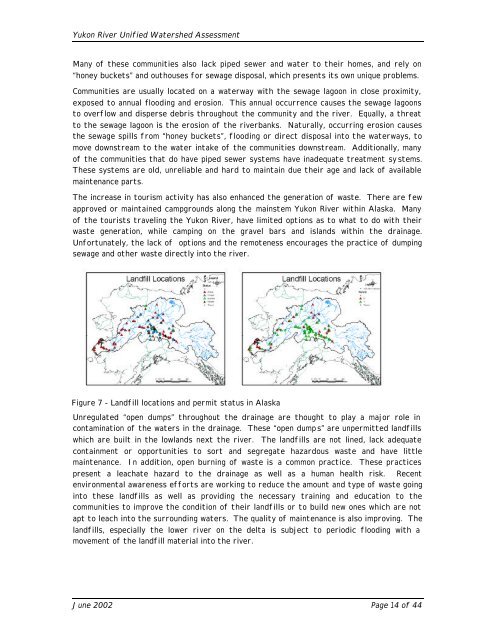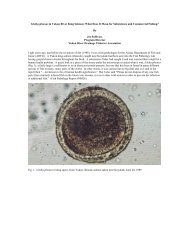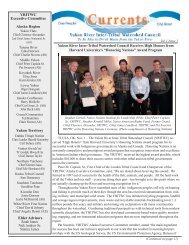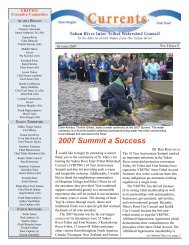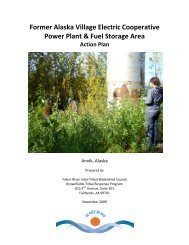Yukon River Unified Watershed Assessment - Yukon River Inter ...
Yukon River Unified Watershed Assessment - Yukon River Inter ...
Yukon River Unified Watershed Assessment - Yukon River Inter ...
Create successful ePaper yourself
Turn your PDF publications into a flip-book with our unique Google optimized e-Paper software.
<strong>Yukon</strong> <strong>River</strong> <strong>Unified</strong> <strong>Watershed</strong> <strong>Assessment</strong><br />
Many of these communities also lack piped sewer and water to their homes, and rely on<br />
“honey buckets” and outhouses for sewage disposal, which presents its own unique problems.<br />
Communities are usually located on a waterway with the sewage lagoon in close proximity,<br />
exposed to annual flooding and erosion. This annual occurrence causes the sewage lagoons<br />
to overflow and disperse debris throughout the community and the river. Equally, a threat<br />
to the sewage lagoon is the erosion of the riverbanks. Naturally, occurring erosion causes<br />
the sewage spills from “honey buckets”, flooding or direct disposal into the waterways, to<br />
move downstream to the water intake of the communities downstream. Additionally, many<br />
of the communities that do have piped sewer systems have inadequate treatment sy stems.<br />
These systems are old, unreliable and hard to maintain due their age and lack of available<br />
maintenance parts.<br />
The increase in tourism activity has also enhanced the generation of waste. There are few<br />
approved or maintained campgrounds along the mainstem <strong>Yukon</strong> <strong>River</strong> within Alaska. Many<br />
of the tourists traveling the <strong>Yukon</strong> <strong>River</strong>, have limited options as to what to do with their<br />
waste generation, while camping on the gravel bars and islands within the drainage.<br />
Unfortunately, the lack of options and the remoteness encourages the practice of dumping<br />
sewage and other waste directly into the river.<br />
Figure 7 - Landfill locations and permit status in Alaska<br />
Unregulated “open dumps” throughout the drainage are thought to play a major role in<br />
contamination of the waters in the drainage. These “open dump s” are unpermitted landfills<br />
which are built in the lowlands next the river. The landfills are not lined, lack adequate<br />
containment or opportunities to sort and segregate hazardous waste and have little<br />
maintenance. In addition, open burning of waste is a common practice. These practices<br />
present a leachate hazard to the drainage as well as a human health risk. Recent<br />
environmental awareness efforts are working to reduce the amount and type of waste going<br />
into these landfills as well as providing the necessary training and education to the<br />
communities to improve the condition of their landfills or to build new ones which are not<br />
apt to leach into the surrounding waters. The quality of maintenance is also improving. The<br />
landfills, especially the lower river on the delta is subject to periodic flooding with a<br />
movement of the landfill material into the river.<br />
June 2002 Page 14 of 44


